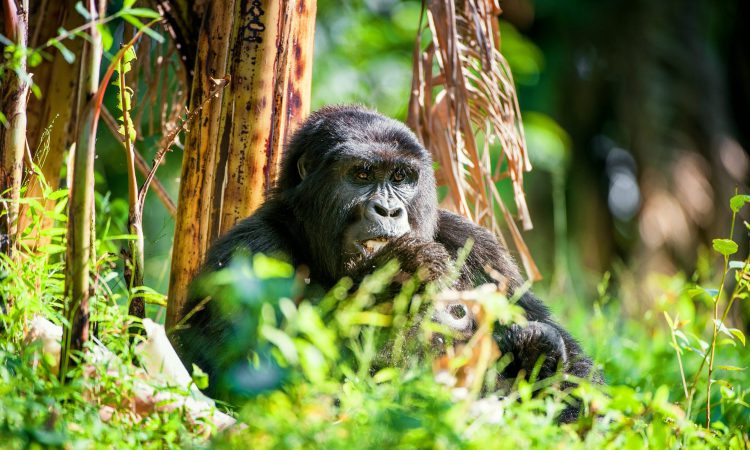Need to know more about silverback gorillas? Here we bring to you all that you need to know about silverback gorillas in the wild. The term ‘silverback’ generally means adult male gorillas. Upon reaching maturity stage, male gorillas grow silver-colored hair/grayish hair on their backs hence the term silverback. They can easily be identified while on gorilla trekking adventure in Uganda, Rwanda and the DR Congo given their rare color and massive size.
Silverbacks are strong, muscular, massive and the strongest of all leads the entire gorilla family or group, protects the rest of the members, finds where the rest of the members in the family forage from and even retire for the night. Gorillas live in families or groups and like humans, silverbacks are the heads of the families, a unique trait you will witness on gorilla trekking safari in Uganda, Rwanda and DRC.
At what age do gorillas become silverbacks?
Male gorillas become mature at 8 years though they may not be fully grown. They will keep growing and develop black air for a period of 4 years. At this age, they can leave their original group and live independently or join another family of other males of related age. They become silverbacks at 13 years and not all gorillas become silverbacks except only males.
Where do silverback gorillas live?
Silverback gorillas exist in East Africa, Central and Western Africa. They can be spotted across the 2 gorilla species. The lowland gorillas dwell mostly in Central and Western African states and they range at altitude of 5000 feet.
The Eastern gorilla specifically the mountain gorillas thrive in the rain-forests of Virunga Massifs and Bwindi Impenetrable National Park at altitude of 7000-13000 feet. The mountain gorillas that thrive in the Virunga Mountain ranges can be trekked in Uganda’s Mgahinga Gorilla National Park, Volcanoes National Park in Rwanda and the Virunga National Park in DRC. These 3 parks make up the Virunga Conservation Area (VCA). Like lowland gorillas, mountain gorillas depend largely on vegetation and at times on insects.
What is the social structure of gorillas?
Generally, gorillas have a social structure of between 5 and over 30 members but this may vary depending on the species, availability of resources and reproductive rate. In every gorilla family, there are adults, males, females, juveniles, infants among others.
A silverback gorilla defines his family’s territory and he has breeding rights to any of the adult females in the group.
How tall or strong are silverback gorillas?
A silverback gorilla can grow 6 feet tall unlike mature females that grow up-to 5 feet tall. Gorillas can weigh about 350 pounds which is twice the weight of an adult man. Silverback gorillas are generally stronger than humans about 7-18 times.
Why do silverback gorillas charge?
Silverback gorillas can charge depending on the circumstances and they do so by thumping their chests, scream. These can also be signs that they are communicating to each other, playing, in case of intimidation or to let the rest of the gorilla members of danger.
When to see silverback gorillas?
Silverback gorillas can be trekked in Africa at any time of the year. But the dry season is of doubt the best time to see these massive creatures in the wild. That is from June to September and December to February. Traveling during the dry season to see silverback gorillas is amazing since very low rainfall is recorded and the ground remains drier.
There is also a possibility to trek to see silverbacks during the wet or rainy season-from March to May and October to November although the challenge is that heavy rains occur during this period.
What to carry during silverback gorilla trekking?
Essential items you must have during silverback gorilla trek include a valid gorilla permit, long-sleeved shirt, trousers, sweater, rain-jacket/poncho, passport, daypack, camera with no flashlight, walking stick (find it at the park offices/lodge), first aid kit, insect repellent, sun screen, ant-malarial prescribed medications among others.





